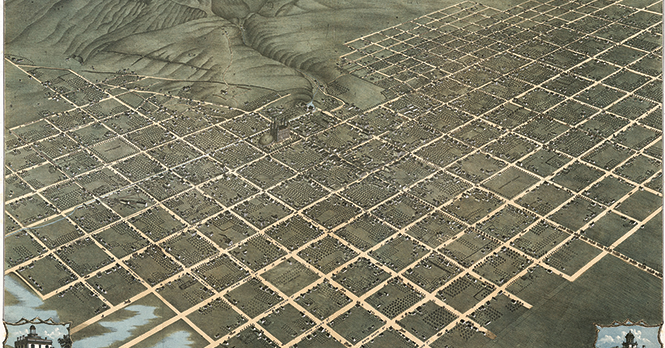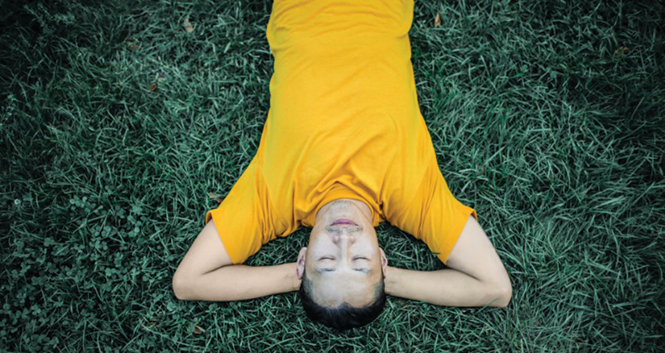Flat Life | Cover Story | Salt Lake City
“When I use a word … itmeansjust what Ichoose it to mean—neither more nor less.”
—Humpty Dumpty, Alice in Wonderland
In Alice in Wonderland and other literature, “flat” denotes a character who is less than three-dimensional. He laughs or cries, but never both. The flat villain is merely villainous. She doesn’t have a Facebook page, practice Tai Chi or listen to yacht rock on Pandora. She is a stereotypical character whose purpose it is to keep the gears of the plot turning with her villainy.
A “round” character, on the other hand, has enough human complexity to make readers laugh and cry.
In skiing, flat light creates problems on overcast days. Without the sun’s contrasting light, sitzmarks, depressions and moguls become invisible hazards on a slope that looks like a negative of an overexposed photograph.
In topography, a flatland is an undifferentiated, horizontal landscape whose sightlines reach the horizon. Of the prairie flatland, Spanish explorer Francisco Vazquez de Coronado wrote: “The country is so level that men became lost when they went off half a league.” Fortunately, Utah’s Bonneville Salt Flats are framed by distant mountains, reference points on the way home.
In politics, the words of Utah Sen. Mike Lee often fall embarrassingly flat. Lee’s response to climate change? “Get married and have some kids.” Utah representatives Chris Stewart and Burgess Owens are Fox News talking heads who can be counted on to make pronouncements that are flat nonsense.
In music, a flat is a half tone lower than the correct pitch. A sharp is the opposite, a half-tone higher. Both are represented by the black keys on a piano. There, in black and white, resides a cryptogram: You can B flat but not B sharp.
In taxation, Utah is one of 10 states with a flat tax on income. Everybody pays 4.95% no matter how much they earn in a year. The state also collects excise tax on various commodities. These so-called sin taxes are flat, per-unit assessments: $1.70 for a pack of Marlboros; $2.40 for a bottle of Barton Vodka, the favorite of Utah sinners. Medical cannabis may not be taxed in the traditional sense, but lawmakers made sure to get their taste by attaching a flat per-transaction charge of $3 at dispensaries.
What quality of flatness do these few “flats” share? What connects a flat of petunias, a glass of flat beer, a case of flat feet, a flattened building, the flat vowel in “cat”? The answer is elusive.
That “flat” is a homonym doesn’t make it any easier. Like “set,” which has more than 400 different definitions, flat has many meanings. It is also a shape-shifter. Flat can be a noun, verb, adjective or adverb. Some forms have circulated in the English language for centuries. The adjective, meaning prostrate, predates Coronado and the conquistadors.
However, none of flat’s various forms light up a sentence like “lickspittle” does in a pairing with “Mike Pence.” Flatness does appeal to runners, cyclists, surveyors and some manufacturers. Moving the needle on the popularity meter are flat stomachs, GI-style flat-top haircuts and leather ballet flats. A corseted Elizabethan bosom is not popular, witness the number of women paying for breast augmentation.
But wait! There’s more. City Weekly is flat proud to offer these few random observations of how “flat” figures in the wonderland that is Utah:
Flatten the curve
Who can forget last year’s impassioned pleas by New York’s now-former Gov. Andrew Cuomo and Dr. Anthony Fauci? Save the hospitals by avoiding spikes of coronavirus infections. (Utah Gov. Gary Herbert’s hand-wringing appeals were flat forgettable.)
While Trump fiddled, New York City burned with infection. Doctors and nurses died. Refrigerator trucks became makeshift morgues. In the face of Trump’s dissembling, public health officials resorted to graphs and numbers. The Salt Lake Tribune put Andy Larsen, a self-described “coronavirus stats guy,” on the COVID-19 beat. His column ran on Page 1, deconstructing human suffering by the numbers.
A year later, with more than 612,000 Americans killed by COVID-19, numbers and percentages have lost their immediacy. Larsen has been moved to the inside pages. There, his column keeps company with the thoughts and prayers routinely accorded to victims of mass shootings. The public has chronic COVID-19 fatigue. People are tired of the mask and the isolation. Many want bread and circuses. They recoil at the prospect of signs on entries—”No shirt, No shoes, No mask, No service.”
Newscasters often read COVID-19 statistics from a PowerPoint display. They evoke the military briefers in Vietnam who reported enemy body count in daily press conferences known derisively as the “Five O’Clock Follies.” The body count metric proved to be specious. Countless Vietnamese soldiers were killed, but the U.S. lost the war.
Just like that misbegotten war, the pandemic is too complex and too politicized to be reduced to numbers. As new, more virulent variants spread and hospital ICUs overflow once again, only two data points are telling: The percentage of newly hospitalized COVID-19 patients who are unvaccinated, and the number of vaccinated patients dying from a break-through infection.

The World Is Flat
In Coronado’s time, a hand-drawn map of a flat Earth depicted vast areas of uncharted terra incognita and the annotation, “Here be dragons.” It has been a long time since Pythagoras posited the world was not flat, but a surprising number of Americans are skeptical. The so-called Flat-Earthers and their QAnon brethren probably have supporters living in Utah County who keep a loaded AR-15 under the bed just in case a dragon runs amok.
Flat-Earthers who bought a ticket to hear Thomas Friedman boost his bestselling book, The World Is Flat, at Abravanel Hall a few years ago must have been disappointed. Friedman’s book title is figurative, not literal. “Flat world” is a metaphor for globalized commerce. Technology has levelled the playing field for the work that makes Silicon Slopes in Utah possible and call centers in India profitable. The flattened world makes an inland port potentially lucrative. It also makes Biden’s $100 billion broadband internet initiative essential to rural Utah.

Flat as a Pancake
Friedman’s world of commerce may be as flat as a worn-out simile, but not all pancakes are created equal. At least one variety is round, not flat. Aebleskiver, a Danish staple, is the size of a lacrosse ball.
Only one restaurant in Utah makes the “fluffy Danish pancake ball,” says Dalena Kelley, the owner of Ruca’s restaurant in Garden City. Ruca’s makes almost 1,000 aebleskiver pancakes a day using a recipe passed down from Kelley’s Danish grandmother.
Traditional, flat pancakes have their own fan base. Penny Ann’s Café’s “light and airy, heavenly, cream cheese hotcakes” are touted as the best in Utah. A café with an East Coast diner personality, Penny Ann’s has been selling plate-size stacks of pancakes to happy customers since 2011.
But they could be happier. When it comes to happiness, the Danes rank No. 2 on the list of the happiest countries in the world. The United States trails at No. 18. The rankings don’t vary much from year to year. Are the Danes’ smiles the result of Scandinavian democratic socialism? Or aebleskiver pancakes for dinner?

Flatbread
Carb junkies are easy to please. They will eat almost anything so long as they are not caught flat-footed without bread. When hosting carboholics for dinner, delight them with a garlic bread appetizer, followed by two vegetable sides—cornbread and zucchini bread—and bread pudding for dessert.
To complement the corn and zucchini, flatbread pizza is a perfect choice. Of all the flatbreads on the market—naan, pita, tortilla, injera—only one’s lineage includes events in 17th-century Italy and the status of an official UNESCO art form.
Salt Lake City is blessed with two authentic Neapolitan flatbread pizza restaurants: Settebello Pizzeria Napolitana and Flatbread Neapolitan Pizzeria. Both are certified by the Associazione Verace Pizza Napoletanain Italy; both practice the Neapolitan pizza-making art registered on UNESCO’s cultural heritage list; and both serve up a toothsome “pizza for the senses with the flavor of well-baked bread” (and a flatbed load of carbs).

Flat Tires
The end of summer brings goat-head season to the Jordan River Parkway Trail. Every cyclist who rides along the 45-mile parkway has a goat-head story. Most involve repeated stops to replace deflated tubes or a long walk pushing a bike with two flat tires.
The goat head, a thumbtack-like burr, is the seed of the Puncturevine, a Class 3 noxious weed in Utah like thistle and tamarisk. It is exquisitely evolved to spike pneumatic tires.
Each flat, ground-hugging plant casts scores of goat head-shaped burrs, and in an encounter with a bunch of them, a bike tire can deflate in 10 seconds flat. The onset of autumn brings five goat-head casualties a day on average to the Guthrie Bicycle Co. Ending the goat head scourge is a challenge the Jordan River Commission has taken on imaginatively. An eradication campaign, now in its third summer, pays a bounty of $2 a pound for uprooted Puncturevines, says program manager Moriah Jackson Ivory.

Flat-screen TV
To set an example, Jimmy Carter had solar panels installed on the roof of the White House. So did Barack Obama. Donald Trump had a 60-inch, flat-screen TV installed in the presidential dining room so he could watch his own antics on screen. He is not the only one to get another TV set. One-third of American households own four or more flat-screen TVs. Some are mounted on the ceiling; some are placed so dogs can watch. (For a pittance, a stay-at-home pet can binge-watch DOGTV, “a trusted source of scientifically developed content for dogs.”)
Television is “a weapon of mass distraction,” observed the late TV writer Larry Gelbart. It may distract lonely dogs, but a television set has been the ruin of many a good bar. It used to be that the best watering holes fostered conversation in dark, quiet interiors. No more! Come the violet hour at the end of the workday—”a time of hush and wonder,” wrote Bernard DeVoto, one of Utah’s premier writers—the glare and blare of flat-screen TVs carpet-bomb the room. Conversation goes MIA. So do “hush” and “wonder.”

Geometry of Flat
At the conclusion of a handcart-reenactment season in Alcova, Wyoming, hundreds of young Mormons have had their testimonies bolstered by dragging a handcart over rough terrain. Some of them struggle up the steep rise of Rocky Ridge where Mormon immigrants foundered in the snow in 1856. Others wade the Sweetwater River where in high water, pioneer wagons crossed like flat-bottom boats. The youthful re-enactors return home with a respect for the concepts of slope and summit.
Measured by a protractor, “flat” is defined as a half-circle angle—180 degrees less than a circular 360 degrees—a straight angle, in other words, capable of centering the bubble on a carpenter’s spirit level. Flat is unequivocal. It brooks no angularities, curves or hills like white elephants. It can, however, generate a shimmering mirage. A tabletop mesa may or may not be flat, but a soccer pitch is as flat as the job-approval rating of Utah’s freelancing attorney general, Sean Reyes.
Utah’s capital city sprawls across a horizontal plane, flanked by mountains, overlaid with a street grid that Joseph Smith, founder of the Latter-day Saints religion, called the Plat of Zion. Anchoring the grid is the Salt Lake Meridian which extends on a north-south axis from Temple Square. The city’s wide streets are fairly flat and smooth, but as every cyclist will attest, too many are butt-bruising bumpy.
The Bonneville Speedway is optimally flat and smooth. The iconic raceway northeast of Wendover put Utah on the map in the early 1900s. Cars were setting land speed records there years before the red-rock Mighty Five became national monuments, decades before a skier braved the slopes in the Cottonwood canyons. While Speed Week at the Bonneville Speedway no longer draws the crowd it once did, not a few betrothed couples race to the salt flats when a reflective veneer of water and a mellow cast of light converge for an enviable wedding photo.

Flat Roof
Sprague Library reopened recently. It had been closed in order to restore its interior after a rain-swollen Parleys Creek flooded the building in 2017. The restoration leaves a clean, well-lighted space redolent of books and fresh paint. It is a retreat from the hurly-burly outside its doors in the heart of Sugar House.
There are some obvious changes—a relocated staircase, for instance—but the exterior is largely unchanged since 1935 when the American Library Association named Sprague the Most Beautiful Branch Library in America. Its best feature is the slate-clad, gable roof. Soon to be 100 years old, the roofing slates are a tweedy mix of earth tones—blue-gray, tan and mauve. The combination makes for one of the most attractive buildings in the city.
Sprague’s Tudor-inspired gables are a stark contrast to the flat-roofed apartment buildings that have sprung up nearby. The visual effect is jarring. Would that it were a rare sight in Salt Lake City, but it is not. The city suffers from a building boom of boxy, low-rise apartment buildings with roofs like mortarboards. They have all the charm of a government office building.
The unattractive buildings are known as “podiums” because of their unvarying design: concrete at the base; no more than five, stud-frame floors above. The best to be said of them is they are fast and cheap to build in a city with a looming housing shortage. A surfeit of podium buildings is already in place along the Trax lines, but many more are planned. The urban aesthetic has been permanently changed by them as if blandness were a virtue.
Fifty years from now, Utahns will be asking why we allowed the city’s streets to be lined with squat, cookie-cutter buildings. And why we allowed a featureless design to be the defining feature of the cityscape. No voice of protest will be raised when the aging podiums are targeted by redevelopers’ bulldozers.

Lying Flat
The latest trend in China is tang ping. It translates as “lying flat.” To the emerging counterculture movement among China’s millennials, lying flat means “to forgo marriage, not have children, stay unemployed and eschew such material wants as a house and a car,” according to The New York Times. It seems familiar, doesn’t it? Think of such engaging slackers as Jeffrey “The Dude” Lebowski. Or Timothy Leary’s 1966 rallying call: “Turn on, tune in, drop out!”
But before dropping out of this admittedly whimsical romp, consider the lexical ground we have covered: from pandemic to pancakes to politicians—all without so much as a nod to Flat Stanley, a favorite book of fourth- and fifth-graders for decades.
You have read 77 “flats” to this point with three more to go. Now, consider this concluding fact: As the Chinese were getting used to lying flat, Donald Trump was flat lying most of the time. The Washington Post documented more than 30,000 Trump falsehoods in four years. It is an astounding number, almost as astonishing as the number of Republicans willing to carry the ex-president’s toxic water.
Pray for the day when Trumpism has fallen as flat on its face as Humpty Dumpty, and all the king’s horses and all the king’s men can’t put it back together again.



Comments are closed.